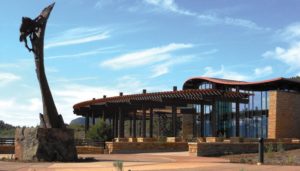
After visiting Canyon of the Ancients National Monument in Colorado, Tom and I continued our exploration of Ancestral Puebloan dwellings. Our intention was to visit Yucca House National Monument, the next closest collection of dwellings to Canyon of the Ancients. However, visiting Yucca House is more difficult than you might expect from a National Park site.
First I went to the website for Yucca House National Monument. The website says that Yucca House is one of the largest archeological sites in southwest Colorado. Ancestral Puebloan people lived there from 1150 through 1300. Yucca House was deeded to the federal government in 1919 by Henry Van Kleeck. Due to its significance as an excellent example of a valley pueblo, Woodrow Wilson made Yucca House a National Monument that same year.
Unlike most Ancient Puebloan structures, Yucca House has not been excavated. It is being preserved as a protected site for a future generation of archaeologists. Today it sits, covered by dirt and grass, indistinguishable from the surrounding landscape. Although the website tells you how to get there, there is no Visitors Center and no facilities at the site. You have to drive on dirt roads, through gates and cattle herds, and up a private driveway to access the monument. When you get there, it looks like a mound of dirt. In other words, they don’t really want you to go and visit the site.
After reading the website and looking at the pictures, Tom and I decided not to visit. Better not to disturb what should not be disturbed. But I wanted the stamp for my passport book. Fortunately the stamp is located at Mesa Verde National Park, not far from Canyon of the Ancients. Tom and I went to Mesa Verde on our big trip west in 2006. We weren’t really interested in seeing the ruins again. But we had never been to the new Mesa Verde Visitors Center which was built in 2012. Even better, the new Visitors Center is located at the bottom of the mountain.

So we drove to the Mesa Verde Visitors Center and admired the parking lot and beautiful architecture. Being a National Park (as opposed to monument or historic site), the Visitors Center was packed with people. We checked out the museum, looked at the research center, wandered through the bookstore, and used the restrooms. Then I got the stamp for Yucca House National Monument in my book and we got back on the road.
Although I wanted to see Yucca House, Tom and I figured we have seen enough excavated Ancestral Puebloan ruins that we weren’t missing much. We will leave the site alone for future generations.
